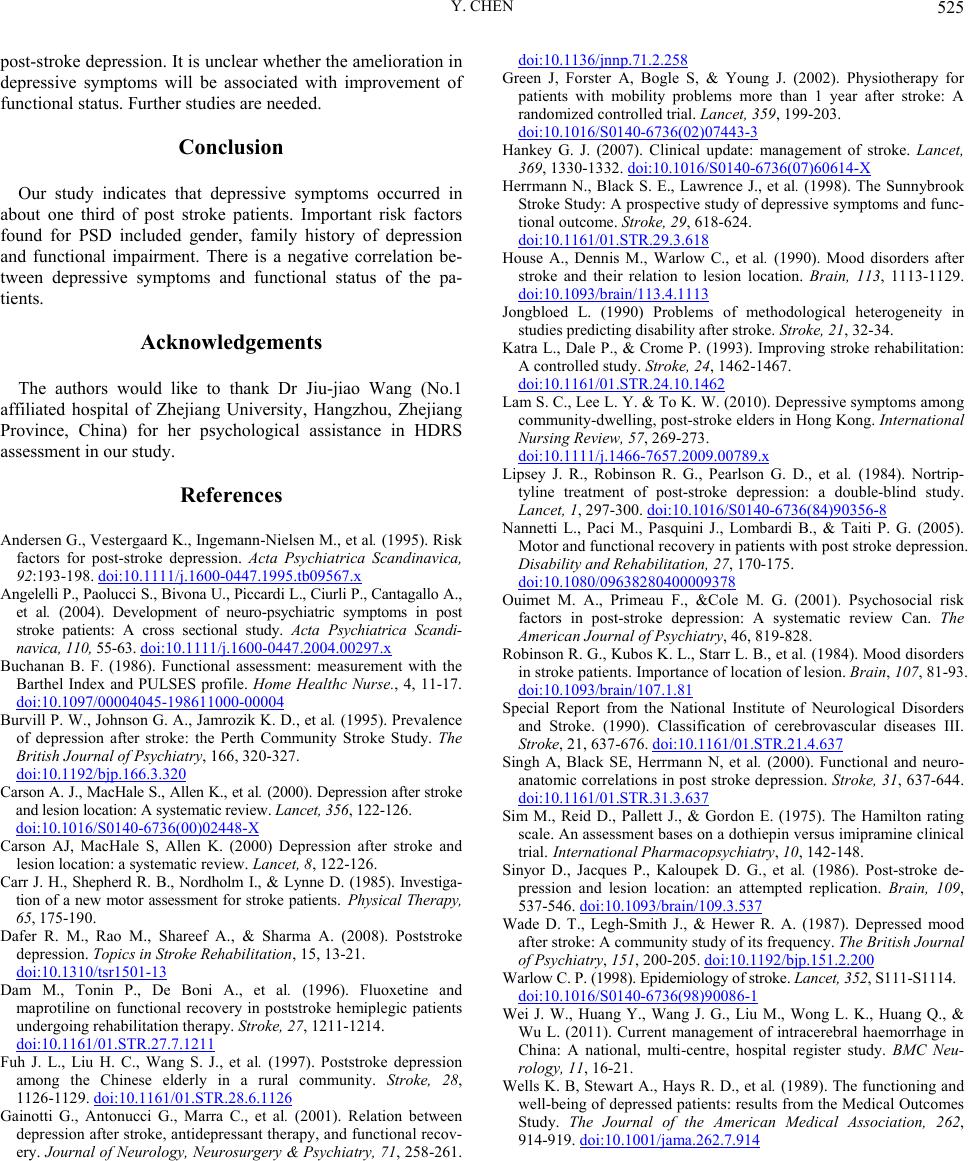
Y. CHEN 525
post-stroke depression. It is unclear whether the amelioration in
depressive symptoms will be associated with improvement of
functional status. Further studies are needed.
Conclusion
Our study indicates that depressive symptoms occurred in
about one third of post stroke patients. Important risk factors
found for PSD included gender, family history of depression
and functional impairment. There is a negative correlation be-
tween depressive symptoms and functional status of the pa-
tients.
Acknowledgements
The authors would like to thank Dr Jiu-jiao Wang (No.1
affiliated hospital of Zhejiang University, Hangzhou, Zhejiang
Province, China) for her psychological assistance in HDRS
assessment in our study.
References
Andersen G., Vestergaard K., Ingemann-Nielsen M., et al. (1995). Risk
factors for post-stroke depression. Acta Psychiatrica Scandinavica,
92:193-198. doi:10.1111/j.1600-0447.1995.tb09567.x
Angelelli P., Paolucci S., Bivona U., Piccardi L., Ciurli P., Cantagallo A.,
et al. (2004). Development of neuro-psychiatric symptoms in post
stroke patients: A cross sectional study. Acta Psychiatrica Scandi-
navica, 110, 55-63. doi:10.1111/j.1600-0447.2004.00297.x
Buchanan B. F. (1986). Functional assessment: measurement with the
Barthel Index and PULSES profile. Home Healthc Nurse., 4, 11-17.
doi:10.1097/00004045-198611000-00004
Burvill P. W., Johnson G. A., Jamrozik K. D., et al. (1995). Prevalence
of depression after stroke: the Perth Community Stroke Study. The
British Journal of P sychiatry, 166, 320-327.
doi:10.1192/bjp.166.3.320
Carson A. J., MacHale S., Allen K., et al. (2000). Depression after stroke
and lesion location: A systematic review. Lancet, 356, 122-126.
doi:10.1016/S0140-6736(00)02448-X
Carson AJ, MacHale S, Allen K. (2000) Depression after stroke and
lesion location: a systematic review. Lancet, 8, 122-126.
Carr J. H., Shepherd R. B., Nordholm I., & Lynne D. (1985). Investiga-
tion of a new motor assessment for stroke patients. Physical Therapy,
65, 175-190.
Dafer R. M., Rao M., Shareef A., & Sharma A. (2008). Poststroke
depression. Topics in Stroke Rehabilitation, 15, 13-21.
doi:10.1310/tsr1501-13
Dam M., Tonin P., De Boni A., et al. (1996). Fluoxetine and
maprotiline on functional recovery in poststroke hemiplegic patients
undergoing rehabilitation therapy. Stroke, 2 7, 1211-1214.
doi:10.1161/01.STR.27.7.1211
Fuh J. L., Liu H. C., Wang S. J., et al. (1997). Poststroke depression
among the Chinese elderly in a rural community. Stroke, 28,
1126-1129. doi:10.1161/01.STR.28.6.1126
Gainotti G., Antonucci G., Marra C., et al. (2001). Relation between
depression after stroke, antidepressant therapy, and functional recov-
ery. Journal of Neurology, Neurosurgery & Psychiatry, 71, 258-261.
doi:10.1136/jnnp.71.2.258
Green J, Forster A, Bogle S, & Young J. (2002). Physiotherapy for
patients with mobility problems more than 1 year after stroke: A
randomized controlled trial. Lancet, 359, 199-203.
doi:10.1016/S0140-6736(02)07443-3
Hankey G. J. (2007). Clinical update: management of stroke. Lancet,
369, 1330-1332. doi:10.1016/S0140-6736(07)60614-X
Herrmann N., Black S. E., Lawrence J., et al. (1998). The Sunnybrook
Stroke Study: A prospective study of depressive symptoms and func-
tional outcome. Stroke, 29, 618-624.
doi:10.1161/01.STR.29.3.618
House A., Dennis M., Warlow C., et al. (1990). Mood disorders after
stroke and their relation to lesion location. Brain, 113, 1113-1129.
doi:10.1093/brain/113.4.1113
Jongbloed L. (1990) Problems of methodological heterogeneity in
studies predicting disability after stroke. Stroke, 21, 32-34.
Katra L., Dale P., & Crome P. (1993). Improving stroke rehabilitation:
A controlled study. Stroke, 24, 1462-1467.
doi:10.1161/01.STR.24.10.1462
Lam S. C., Lee L. Y. & To K. W. (2010). Depressive symptoms among
community-dwelling, post-stroke elders in Hong Kong. International
Nursing Review, 57, 269-273.
doi:10.1111/j.1466-7657.2009.00789.x
Lipsey J. R., Robinson R. G., Pearlson G. D., et al. (1984). Nortrip-
tyline treatment of post-stroke depression: a double-blind study.
Lancet, 1, 297-300. doi:10.1016/S0140-6736(84)90356-8
Nannetti L., Paci M., Pasquini J., Lombardi B., & Taiti P. G. (2005).
Motor and functional recovery in patients with post stroke depression.
Disability and Rehabilitation, 27, 170-175.
doi:10.1080/09638280400009378
Ouimet M. A., Primeau F., &Cole M. G. (2001). Psychosocial risk
factors in post-stroke depression: A systematic review Can. The
American Journal of Psychia tr y, 46, 819-828.
Robinson R. G., Kubos K. L., Starr L. B., et al. (1984). Mood disorders
in stroke patients. Importance of location of lesion. Brain, 107, 81-93.
doi:10.1093/brain/107.1.81
Special Report from the National Institute of Neurological Disorders
and Stroke. (1990). Classification of cerebrovascular diseases III.
Stroke, 21, 637-676. doi:10.1161/01.STR.21.4.637
Singh A, Black SE, Herrmann N, et al. (2000). Functional and neuro-
anatomic correlations in post stroke depression. Stroke, 31, 637-644.
doi:10.1161/01.STR.31.3.637
Sim M., Reid D., Pallett J., & Gordon E. (1975). The Hamilton rating
scale. An assessment bases on a dothiepin versus imipramine clinical
trial. International Pha rm ac op s yc hi atry, 10, 142-148.
Sinyor D., Jacques P., Kaloupek D. G., et al. (1986). Post-stroke de-
pression and lesion location: an attempted replication. Brain, 109,
537-546. doi:10.1093/brain/109.3.537
Wade D. T., Legh-Smith J., & Hewer R. A. (1987). Depressed mood
after stroke: A community study of its frequency. The British Journal
of Psychiatry, 151, 200-205. doi:10.1192/bjp.151.2.200
Warlow C. P. (1998). Epidemiology of stroke. Lancet, 352, S111-S1114.
doi:10.1016/S0140-6736(98)90086-1
Wei J. W., Huang Y., Wang J. G., Liu M., Wong L. K., Huang Q., &
Wu L. (2011). Current management of intracerebral haemorrhage in
China: A national, multi-centre, hospital register study. BMC Neu-
rology, 11, 16-21.
Wells K. B, Stewart A., Hays R. D., et al. (1989). The functioning and
well-being of depressed patients: results from the Medical Outcomes
Study. The Journal of the American Medical Association, 262,
914-919. doi:10.1001/jama.262.7.914